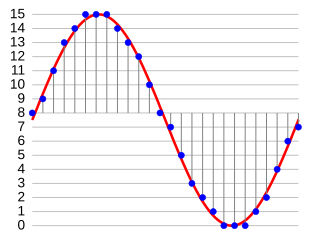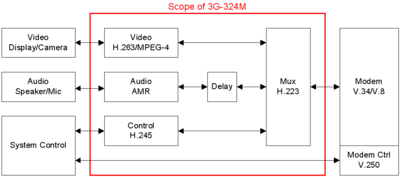
Enhanced Data rates for GSM Evolution (EDGE), also known as 2.75G, Enhanced GPRS (EGPRS), IMT Single Carrier (IMT-SC), and Enhanced Data rates for Global Evolution, is a 2G digital mobile phone technology for data transmission. It is a subset of General Packet Radio Service (GPRS) on the GSM network and improves upon it offering speeds close to 3G technology, hence the name 2.75G.

The Global System for Mobile Communications (GSM) is a standard developed by the European Telecommunications Standards Institute (ETSI) to describe the protocols for second-generation (2G) digital cellular networks used by mobile devices such as mobile phones and tablets. GSM is also a trade mark owned by the GSM Association. GSM may also refer to the Full Rate voice codec.

General Packet Radio Service (GPRS), also called 2.5G, is a mobile data standard on the 2G cellular communication network's global system for mobile communications (GSM). Networks and mobile devices with GPRS started to roll out around the year 2001. At the time of introduction it offered for the first time seamless mobile data transmission using packet data for an "always-on" connection, providing improved Internet access for web, email, WAP services, and Multimedia Messaging Service (MMS).
H.263 is a video compression standard originally designed as a low-bit-rate compressed format for videotelephony. It was standardized by the ITU-T Video Coding Experts Group (VCEG) in a project ending in 1995/1996. It is a member of the H.26x family of video coding standards in the domain of the ITU-T.

G.723.1 is an audio codec for voice that compresses voice audio in 30 ms frames. An algorithmic look-ahead of 7.5 ms duration means that total algorithmic delay is 37.5 ms. Its official name is Dual rate speech coder for multimedia communications transmitting at 5.3 and 6.3 kbit/s. It is sometimes associated with a Truespeech trademark in coprocessors produced by DSP Group.
4G is the fourth generation of broadband cellular network technology, succeeding 3G and preceding 5G. A 4G system must provide capabilities defined by ITU in IMT Advanced. Potential and current applications include amended mobile web access, IP telephony, gaming services, high-definition mobile TV, video conferencing, and 3D television.
Adaptive Multi-Rate Wideband (AMR-WB) is a patented wideband speech audio coding standard developed based on Adaptive Multi-Rate encoding, using a similar methodology to algebraic code-excited linear prediction (ACELP). AMR-WB provides improved speech quality due to a wider speech bandwidth of 50–7000 Hz compared to narrowband speech coders which in general are optimized for POTS wireline quality of 300–3400 Hz. AMR-WB was developed by Nokia and VoiceAge and it was first specified by 3GPP.
Customized Applications for Mobile networks Enhanced Logic (CAMEL) is a set of standards designed to work on either a GSM core network or the Universal Mobile Telecommunications System (UMTS) network. The framework provides tools for operators to define additional features for standard GSM services/UMTS services. The CAMEL architecture is based on the Intelligent Network (IN) standards, and uses the CAP protocol. The protocols are codified in a series of ETSI Technical Specifications.
3GP is a multimedia container format defined by the Third Generation Partnership Project (3GPP) for 3G UMTS multimedia services. It is used on 5G phones.
The IP Multimedia Subsystem or IP Multimedia Core Network Subsystem (IMS) is a standardised architectural framework for delivering IP multimedia services. Historically, mobile phones have provided voice call services over a circuit-switched-style network, rather than strictly over an IP packet-switched network. Various voice over IP technologies are available on smartphones; IMS provides a standard protocol across vendors.
PacketCable network is a technology specification defined by the industry consortium CableLabs for using Internet Protocol (IP) networks to deliver multimedia services, such as IP telephony, conferencing, and interactive gaming on a cable television infrastructure.
H.320 or Narrow-band visual telephone systems and terminal equipment is an umbrella Recommendation by the ITU-T for running multimedia (audio/video/data) over ISDN based networks. The main protocols in this suite are H.221, H.230, H.242, audio codecs such as G.711 (PCM) and G.728 (CELP), and discrete cosine transform (DCT) video codecs such as H.261 and H.263.
H.324 is an ITU-T recommendation for voice, video and data transmission over regular analog phone lines. It uses a regular 33,600 bit/s modem for transmission, the H.263 codec for video encoding and G.723.1 for audio.
The Mobile Application Part (MAP) is an SS7 protocol that provides an application layer for the various nodes in GSM and UMTS mobile core networks and GPRS core networks to communicate with each other in order to provide services to users. The Mobile Application Part is the application-layer protocol used to access the Home Location Register, Visitor Location Register, Mobile Switching Center, Equipment Identity Register, Authentication Centre, Short message service center and Serving GPRS Support Node (SGSN).
Text over IP is a means of providing a real-time text (RTT) service that operates over IP-based networks. It complements Voice over IP (VoIP) and Video over IP.

H.323 is a recommendation from the ITU Telecommunication Standardization Sector (ITU-T) that defines the protocols to provide audio-visual communication sessions on any packet network. The H.323 standard addresses call signaling and control, multimedia transport and control, and bandwidth control for point-to-point and multi-point conferences.

Video Share is an IP Multimedia System (IMS) enabled service for mobile networks that allows users engaged in a circuit switch voice call to add a unidirectional video streaming session over the packet network during the voice call. Any of the parties on the voice call can initiate a video streaming session. There can be multiple video streaming sessions during a voice call, and each of these streaming sessions can be initiated by any of the parties on the voice call. The video source can either be the camera on the phone or a pre-recorded video clip.

Image Share is a service for sharing images between users during a mobile phone call. It has been specified for use in a 3GPP-compliant cellular network by the GSM Association in the PRD IR.79 Image Share Interoperability Specification.
The 3GPP/NGN IP Multimedia Subsystem (IMS) multimedia telephony service (MMTel) is a global standard based on the IMS, offering converged, fixed and mobile real-time multimedia communication using the media capabilities such as voice, real-time video, text, file transfer and sharing of pictures, audio and video clips. With MMTel, users have the capability to add and drop media during a session. You can start with chat, add voice, add another caller, add video, share media and transfer files, and drop any of these without losing or having to end the session. MMTel is one of the registered ICSI feature tags.
ViLTE, an acronym for "Video over LTE", is a conversational video service based on the IP Multimedia Subsystem (IMS) core network like VoLTE. It has specific profiles for the control and VoLTE of the video service and uses LTE as the radio access medium. The service as a whole is governed by the GSM Association in PRD IR.94.







